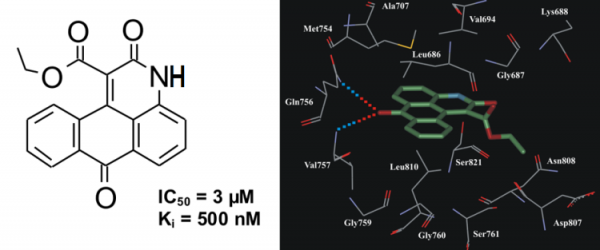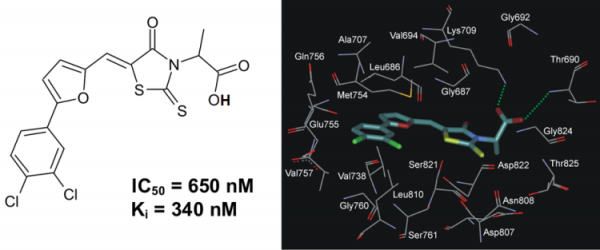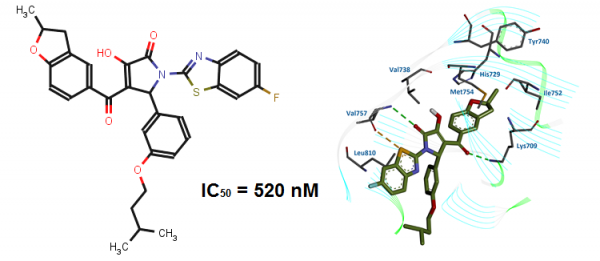Apoptosis signal-regulating kinase 1 (ASK1, also termed MAP3K5) is a mitogen-activated protein kinase (MAPK) that is involved in transduction of apoptotic signals under a variety of stress conditions. A series of studies have indicated that ASK1 plays important roles in many cardiovascular, neurodegenerative diseases and cancer suggesting that small-molecule compounds inhibiting ASK1 could possibly be used for the amelioration of the development of these pathologies.
OTAVAchemicals Ltd. has developed two novel classes of ASK1 using both in silico and in vitro approaches. The virtual screening experiments were carried out targeting the ATP binding site of ASK1 with the OTAVAchemicals’s in-stock compound collection. The most promising compounds have been selected and taken for the kinase assay study.
3H-naphtho[1,2,3-de]quinoline-2,7-diones
In vitro kinase assay revealed that derivatives of 3H-naphtho[1,2,3-de]quinoline-2,7-dione possess inhibitory activity towards ASK1. Compound ethyl 2,7-dioxo-2,7-dihydro-3H-naphtho[1,2,3-de]quinoline-1-carboxylate (NQDI-1) inhibited ASK1 with a Ki of 500 nM (Fig. 1). In our preliminary selectivity study this compound exhibited specific inhibitory activity towards ASK1 (Table 1).

Fig.1. The chemical structure of inhibitor NQDI-1 and its binding mode in ASK1 active site.
Table 1. Residual Activity of Protein Kinases (%) in the Presence of NQDI-1 at 25 μM Concentration
|
ASK1 |
Aurora A |
ROCK |
HGFR |
FGFR1 |
Tie2 |
JNK3 |
CK2 |
|
12.5 |
79 |
100 |
62 |
44 |
84 |
100 |
78 |
It was reported that NQDI-1 has prevented ROS-mediated apoptosis in the NG108-15 neuronal cell line (Nomura et al., Neurosci Lett. 2013, 549, 63). Moreover, the administration of NQDI-1 to laboratory animals attenuated renal dysfunction and histological changes characteristic for renal ischemia/reperfusion injury (El Eter, Cardiovasc Hematol Agents Med Chem. 2013, 11, 179). Therefore, inhibitor NQDI-1 has strong pharmacological potential.
References:
-
Identification of 3H-naphtho[1,2,3-de]quinoline-2,7-diones as inhibitors of apoptosis signal-regulating kinase 1 (ASK1). Volynets GP, Chekanov MO, Synyugin AR, Golub AG, Kukharenko OP, Bdzhola VG, Yarmoluk SM. J Med Chem. 2011, 54(8):2680-2686.
5-(5-Phenyl-furan-2-ylmethylene)-2-thioxo-thiazolidin-4-ones
A series of 5-(5-Phenyl-furan-2-ylmethylene)-2-thioxo-thiazolidin-4-one derivatives has been synthesized and evaluated in vitro toward human protein kinase ASK1. It was revealed that compound 2-{5-[5-(3,4-dichlorophenyl)-furan-2-ylmethylene]-4-oxo-2-thioxo-thiazolidin-3-yl}-propanoic acid (PFTA-1) inhibited ASK1 with a Ki of 340 nM (Fig. 2).

Fig. 2. The chemical structure of inhibitor PFTA-1 and its binding mode with ASK1 active site.
Table 2. Residual Activity of Protein Kinases (%) in the Presence of PFTA-1 at 10 μM Concentration
|
ASK1 |
Aurora A |
HGFR |
FGFR1 |
Tie2 |
JNK3 |
CK2 |
|
3 |
14 |
65 |
88 |
29 |
46 |
34 |
The inhibitory profiles of PFTA-1 were investigated on a small panel of protein kinases. These studies have demonstrated that PFTA-1 is a selective inhibitor of ASK1.
References:
-
Rational design of apoptosis signal-regulating kinase 1 inhibitors: discovering novel structural scaffold. Volynets GP, Bdzhola VG, Golub AG, Synyugin AR, Chekanov MO, Kukharenko OP, Yarmoluk SM. Eur. J. Med. Chem. 2013, 61: 104-115.
Benzothiazol-2-yl-3-hydroxy-5-phenyl-1,5-dihydro-pyrrol-2-one
We have identified novel chemical class of ASK1 inhibitors, namely benzothiazol-2-yl-3-hydroxy-5-phenyl-1,5-dihydro-pyrrol-2-one, using molecular modeling techniques. It was found that the most active compound 1-(6-fluoro-ben- zothiazol-2-yl)-3-hydroxy-5-[3-(3-methyl-butoxy)-phenyl]-4-(2-methyl-2,3-dihydro-benzofuran-5-carbonyl)-1,5-dihydro-pyrrol-2-one (BPyO-34) inhibits ASK1 with IC50 of 520 nM in vitro in kinase assay (Fig. 3).

Fig. 3. The chemical structure of inhibitor BPyO-34 and its binding mode with ASK1 active site.
Table 3. Residual Activity of Protein Kinases (%) in the Presence of BPyO-34 at 10 μM Concentration
|
ASK1 |
Aurora A |
FGFR1 |
Tie2 |
JNK3 |
CK2 |
|
14 |
45 |
100 |
100 |
100 |
83 |
The inhibitory profiles of BPyO-34 were investigated on a small panel of protein kinases. These studies have demonstrated that BPyO-34 is a selective inhibitor of ASK1.
References:
-
Identification of apoptosis signal-regulating kinase 1 (ASK1) inhibitors among the derivatives of benzothiazol-2-yl-3-hydroxy-5-phenyl-1,5-dihydro-pyrrol-2-one. Sergiy A. Starosyla, Galyna P. Volynets, Sergiy S. Lukashov, Oksana B. Gorbatiuk, Andriy G. Golub, Volodymyr G. Bdzhola, Sergiy M. Yarmoluk. Bioorganic & Medicinal Chemistry. 2015, 23: 2489-2497.
ASK1 Pharmacophore Model Derived from Diverse Classes of Inhibitors
The three-dimensional pharmacophore model of ASK1 inhibitors has been developed with PharmaGist program (Fig. 3). The positions of pharmacophore features in the model correspond to conformations of highly active ASK1 inhibitors in which they interact with ATP-binding site of ASK1.

Fig. 3. ASK1 inhibitors pharmacophore model
The generated pharmacophore model allows accurately predict active and inactive compounds and can be of great use for virtual screening aimed at discovering novel ASK1 inhibitors.
|
 HOME
HOME ABOUT
ABOUT
 SERVICES
SERVICES
 PRODUCTS
PRODUCTS
 Targeted Libraries
Targeted Libraries
 Biochemicals
Biochemicals
 RESEARCH
RESEARCH
 DOWNLOADS
DOWNLOADS ORDERING
ORDERING
 CONTACTS
CONTACTS




